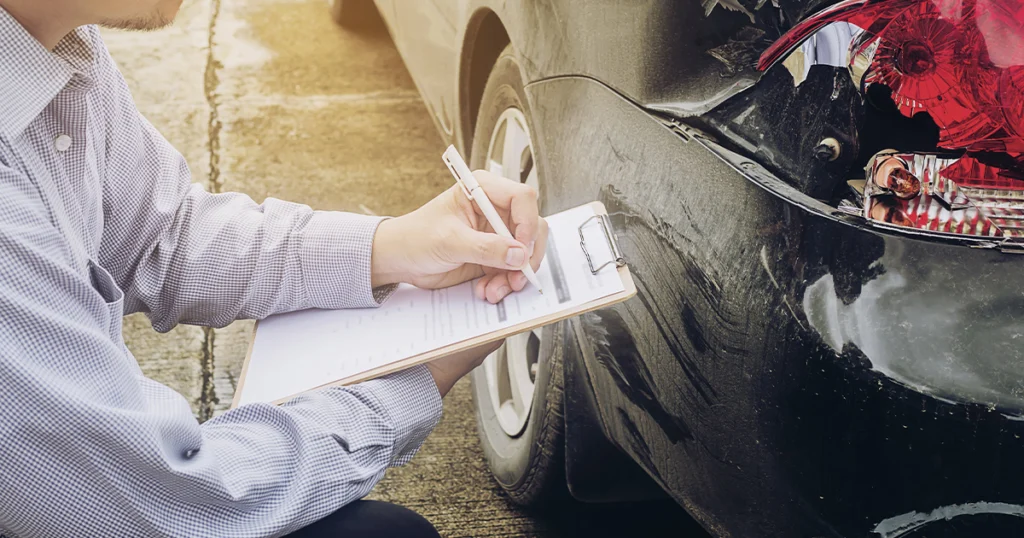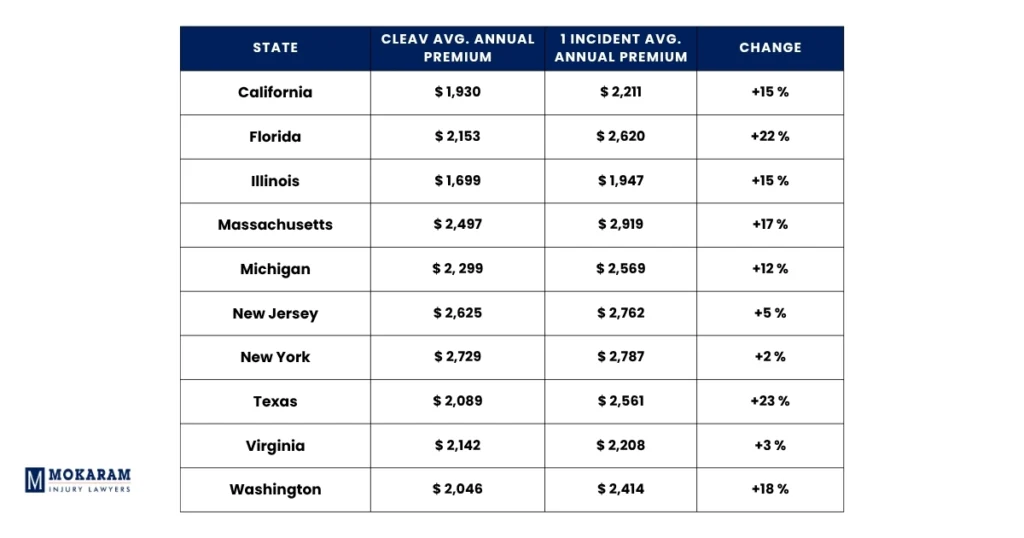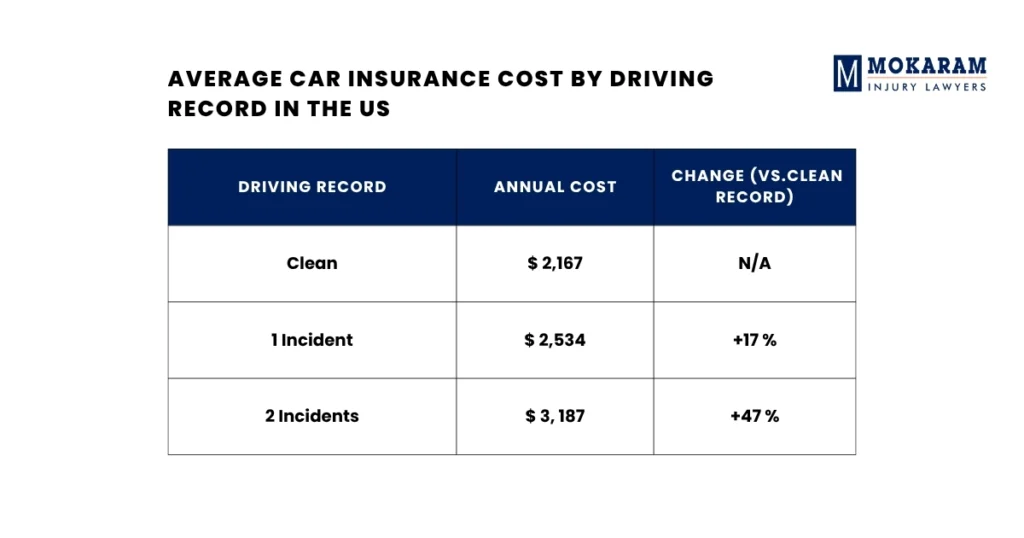
Did you know car insurance premiums can rise by 30% to 50% on average after a single at-fault accident? Beyond repair costs and stress, one of the biggest financial impacts of an accident often comes from your insurance company increasing your rates. Insurers view recent accidents as indicators of higher future risk, which is why even a single at-fault incident can cause a noticeable rate hike.
Insurers use a scoring model that calculates your “risk profile” every renewal cycle. The goal is to adjust your premium in proportion to perceived future risk, making post-accident increases fairly common. If navigating these increases feels overwhelming, an experienced car accident lawyer can help you deal with the insurance company, protect your rights, and guide you through post-accident financial recovery.
How Much Does Insurance Usually Increase After an Accident
The average car insurance increase after an accident can range from 10% to 50%, though it varies based on several factors. Minor accidents, like small fender-benders, often result in smaller increases compared to severe collisions involving major damage or injuries. However, if multiple claims are filed within a short time, the rate hike can be substantial.
Some insurance companies offer accident forgiveness programs, which prevent your first at-fault accident from affecting your rate. Checking whether your insurer provides this option can save you from a long-term financial burden. The picture below shows how much car insurance typically increases after an accident, broken down by state.

Factors That Influence How Much Your Rate Goes Up
Car insurance companies don’t raise premiums randomly, several specific factors determine how much your rate will increase after an accident.
Fault and Severity of the Accident
If you’re found at fault for the accident, your rates will likely rise more significantly than if you weren’t responsible. The severity of the incident also matters , an accident causing property damage, bodily injuries, or total vehicle loss typically leads to a larger premium increase.
Insurance companies review the total payout amount when determining your risk level. Higher claims suggest greater potential future costs, which leads to a higher premium. Even accidents where fault is shared may still influence your rate.
Some insurers use point-based systems to measure fault and severity, assigning “risk points” for each claim type that affect your premium over time.
Your Driving Record
Your driving record before the accident plays a major role in determining how steep your rate increase will be. If you’ve been a safe driver for many years without prior claims, your insurer may offer leniency or smaller surcharges. On the other hand, multiple past violations or accidents will likely trigger higher increases.
A clean record signals reliability and responsibility, encouraging insurers to treat the event as a one-time mistake. Some providers even remove surcharges earlier if you maintain a good record after the accident.
You can also take defensive driving courses to show your commitment to safe driving. These not only help lower rates but can also remove points from your driving record in some states.

Type of Coverage and Insurer
The kind of coverage you carry and which insurer you’re with can influence post-accident rate changes. Drivers with accident forgiveness may avoid a surcharge altogether. Without it, you’ll likely face an increase at renewal time.
Each insurance company has its own formula for calculating post-accident adjustments. Some weigh bodily injury claims more heavily, while others focus on vehicle repair costs or total payouts.
Comparing policies across multiple providers after an accident can reveal more affordable options. Some insurers are more lenient with first-time claimants than others.
Location and State Laws
Where you live affects how insurance companies handle rate increases after an accident. States with no-fault insurance laws require each driver’s insurer to pay for damages, often resulting in higher premiums for both drivers. In contrast, fault-based states generally only penalize the driver responsible for the collision.
Local accident statistics and urban traffic conditions also play a part. Drivers in densely populated areas typically face higher increases due to a greater risk of accidents.
Additionally, state laws may limit how long a surcharge can stay on your record, typically ranging from three to five years. Knowing your local regulations can help you plan ahead.
Claim Amount and Frequency
The more expensive your claim, the higher your premium increase will be. A $500 bumper repair may barely affect your rate, but a $10,000 total loss claim almost certainly will. Insurers assess the total claim cost when deciding how much to raise your premium.
Filing multiple claims within a few years also signals higher risk. Even small, frequent claims can raise red flags, making insurers more cautious about renewing your policy.
Sometimes, paying out-of-pocket for minor damage can be cheaper in the long run. It’s a good idea to calculate how much your rate would increase before filing small claims.
How Long Does the Rate Increase Last
Typically, a post-accident rate increase remains in effect for three to five years. During this time, your insurer monitors your driving record and reassesses your risk at every renewal. If you maintain a clean driving history, your premium will gradually return to its pre-accident level.
Some insurers offer early reduction programs, where rates can drop sooner after one or two years of safe driving. Completing a defensive driving course may also help shorten the duration of the surcharge.
After five years, most insurers remove the accident entirely from your record, provided no new claims have been filed. Consistent safe driving is the key to restoring your old rate faster.
How to Lower Your Insurance Premium After an Accident
Even if your rates go up after an accident, there are several effective ways to reduce them over time.
Compare Insurance Quotes
Each insurance company has its own approach to calculating risk. By comparing multiple quotes, you may find another provider willing to offer lower rates, even after an accident.
Use online comparison tools or contact insurance agents directly to explore your options. You might discover a provider with better forgiveness policies or loyalty discounts.
Switching insurers can be a smart move if your current company penalizes you heavily. Always ensure the new policy offers the same or better coverage.
Increase Your Deductible
Raising your deductible , the amount you pay out of pocket before insurance covers damages , can reduce your monthly premium. This strategy works best if you have a good financial cushion for emergencies.
A higher deductible signals to insurers that you’re less likely to file small claims, which can lower your overall risk profile. However, it’s important not to set your deductible so high that it becomes a burden if another accident happens.
This method helps balance cost savings with manageable risk and can offset a portion of your post-accident rate increase.
Ask About Discounts
Most insurance companies offer multiple discounts that drivers overlook. Bundling your auto and home policies, installing anti-theft devices, or maintaining good credit can all help reduce your rate.
Safe driver programs and low-mileage discounts can also help offset your post-accident increase. Some insurers even offer telematics programs that track your driving behavior and reward safe habits.
Asking your insurer directly about all available discounts ensures you maximize every possible saving opportunity.
Take a Defensive Driving Course
Completing a defensive driving course not only helps you become a safer driver but can also reduce your insurance premiums. Many insurers provide discounts for drivers who complete state-approved programs, especially after an accident.
These courses teach accident-avoidance techniques, awareness strategies, and hazard response skills that lower your likelihood of future claims.
Some states even remove points from your driving record when you complete such courses, which can further improve your insurance rate.
Maintain a Clean Driving Record
After an accident, keeping a spotless driving record is the best way to restore your rates. Avoid traffic violations, DUIs, or further accidents to demonstrate responsible driving behavior.
The longer you maintain a clean record, the more trust your insurer rebuilds in your driving habits. Over time, this leads to rate reductions and eligibility for good driver discounts again.
Consistency is key, every claim-free year counts toward lowering your premium and improving your overall driving profile.
How a Lawyer Can Make the Process Easier
Dealing with the aftermath of a car accident can be overwhelming, especially when insurance companies delay or deny fair settlements. This is where an experienced Houston car accident lawyer can make a world of difference.
A skilled attorney can handle communications with your insurer, gather necessary evidence, and negotiate a fair settlement that covers all your expenses. This ensures you aren’t pressured into accepting a low payout or blamed unfairly for an accident.
Lawyers also help you understand your rights and the fine print in your insurance policy, preventing costly mistakes. With legal representation, you can focus on your recovery while your lawyer handles the complex paperwork, claims, and legal steps.
An attorney’s involvement not only reduces stress but often results in higher compensation for medical bills, vehicle repairs, and lost wages. Simply put, having a lawyer by your side makes the entire post-accident process smoother and more effective.
Let Mokaram Injury Lawyers Handle the Hard Part
At Mokaram Injury Lawyers, we understand how stressful post-accident insurance battles can be. An experienced Houston car accident lawyer from our firm can deal directly with the insurance company, fight for fair compensation, and make sure your rights are protected every step of the way.
Whether you’re facing rising insurance rates, a denied claim, or serious injuries, we’ll guide you through the process with compassion and skill. Don’t let insurance companies take advantage of your situation, let us fight for the justice and recovery you deserve.
At Mokaram Injury Lawyers, we don’t just handle claims, we handle people, with care and commitment. Call us today and take the first step toward protecting your future.